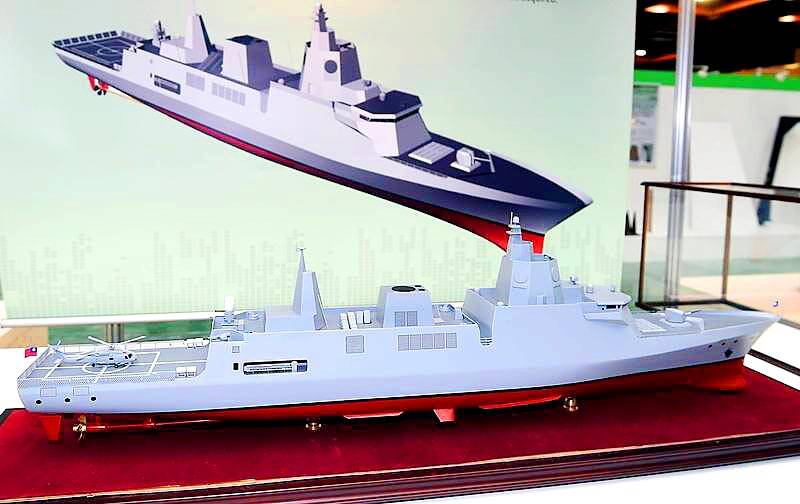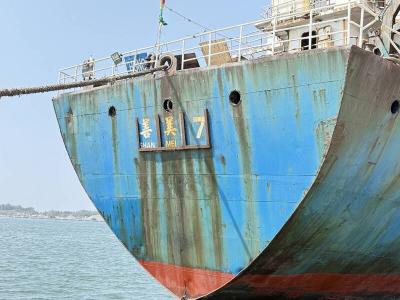Mishandling of a guided missile frigate program has set Taiwan two decades behind its peers, the Control Yuan said yesterday as it handed down a corrective measure against the Navy Command and the Ministry of National Defense over the issue.
Failure to build new frigates on time and in sufficient quantity has robbed the navy of initiative amid the “gray zone” tactics of China, Control Yuan members Lai Ting-ming (賴鼎銘), Lin Wen-cheng (林文程) and Hsiao Tzu-yu (蕭自佑) wrote in a news release.
In 2008, the ministry and top navy brass began plans to obtain a flotilla of next-generation frigates with an emphasis on modern battle management capabilities equivalent to the Aegis combat system, the members said.

Photo: Taipei Times
Defense officials and navy commanders launched two programs to develop the indigenous frigates — the 2012 Xunlian Project for the Aegis-like combat system and other equipment for the ships, and the 2014 Zhenhai Project for the frigates themselves, the members said.
The projects ran into a multitude of setbacks, most of which stemmed from indecision, as the groups involved were unable to agree on a common set of requirements and constantly backpedaled on decisions, they said.
Disagreements erupted a month after the ministry submitted a plan for the projects and the navy demurred from signing a contract for the Zhenhai Project with the Chungshan Institute of Science and Technology, citing the program’s “immaturity,” the members said.
In April 2020, the navy declared that the acquisition of shipborne active electronically scanned array radars (AESA) to replace passive arrays was a high priority and linked the AESA to the Zhenhai Project without changing the project’s timetable, they said.
That meant the navy had reversed its decision to use the Chungshan Institute to build the ships, they said.
Six months later, navy brass moved to terminate the Xunlian Project, citing a failure to meet capability requirements despite its certification to the contrary, they said.
In 2021, the navy scrapped the original concept for frigates with Aegis-equivalent systems altogether, instead proposing to build just two light frigates to counter incursions by the Chinese People’s Liberation Army Navy, they said.
The service had seriously erred in its indecisiveness over the frigate program’s requirements and acting in contradiction to the requirements set by the Zhenhai Project, which accepted the utilization of passive electronically scanned arrays (PESA), they said.
Although Taiwan’s navy in 2017 submitted an AESA solicitation to the Chungshan Institute, the documentation showed that the capability requirements it described were virtually identical to the PESA system proposed in the Zhenhai Project, the members said.
There was no ground for the navy to claim that the institute failed to deliver a system with the required specifications because of the potentially misleading solicitation, they said.
As the party responsible for establishing the performance metrics of the combat system, the navy committed obvious errors in not providing consistent specifications for the capabilities it wanted, they said.
The ramifications of the mistakes include the navy’s loss of initiative in waters around Taiwan, a 20-year technology lag by the standards of regional naval forces and a continued reliance on Chi Yang-class frigates, which have been in service for more than 50 years, they added.
Additional reporting by CNA

An undersea cable to Penghu County has been severed, the Ministry of Digital Affairs said today, with a Chinese-funded ship suspected of being responsible. It comes just a month after a Chinese ship was suspected of severing an undersea cable north of Keelung Harbor. The National Communications and Cyber Security Center received a report at 3:03am today from Chunghwa Telecom that the No. 3 cable from Taiwan to Penghu was severed 14.7km off the coast of Tainan, the Ministry of Digital Affairs said. The Coast Guard Administration (CGA) upon receiving a report from Chunghwa Telecom began to monitor the Togolese-flagged Hong Tai (宏泰)

A cat named Mikan (蜜柑) has brought in revenue of more than NT$10 million (US$305,390) for the Kaohsiung MRT last year. Mikan, born on April 4, 2020, was a stray cat before being adopted by personnel of Kaohsiung MRT’s Ciaotou Sugar Refinery Station. Mikan was named after a Japanese term for mandarin orange due to his color and because he looks like an orange when curled up. He was named “station master” of Ciaotou Sugar Refinery Station in September 2020, and has since become famous. With Kaohsiung MRT’s branding, along with the release of a set of cultural and creative products, station master Mikan

RISING TOURISM: A survey showed that tourist visits increased by 35 percent last year, while newly created attractions contributed almost half of the growth Changhua County’s Lukang Old Street (鹿港老街) and its surrounding historical area clinched first place among Taiwan’s most successful tourist attractions last year, while no location in eastern Taiwan achieved a spot in the top 20 list, the Tourism Administration said. The listing was created by the Tourism Administration’s Forward-looking Tourism Policy Research office. Last year, the Lukang Old Street and its surrounding area had 17.3 million visitors, more than the 16 million visitors for the Wenhua Road Night Market (文化路夜市) in Chiayi City and 14.5 million visitors at Tainan’s Anping (安平) historical area, it said. The Taipei 101 skyscraper and its environs —

Taiwan on Friday said a New Zealand hamburger restaurant has apologized for a racist remark to a Taiwanese customer after reports that it had first apologized to China sparked outrage in Taiwan. An image posted on Threads by a Taiwanese who ate at Fergburger in Queenstown showed that their receipt dated Sunday last week included the words “Ching Chang,” a racial slur. The Chinese Consulate-General in Christchurch in a statement on Thursday said it had received and accepted an apology from the restaurant over the incident. The comment triggered an online furor among Taiwanese who saw it as an insult to the